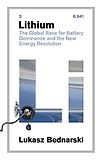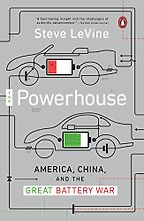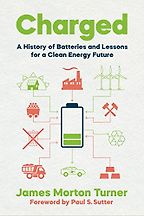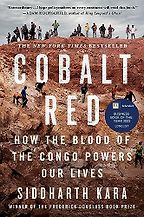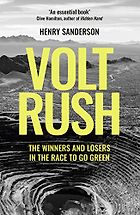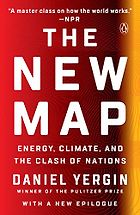Batteries is a really interesting topic to read about because it’s about technology and the future—electric vehicles and the storage of renewable energy—but it’s also about geopolitics. Where oil was found played a big role in 20th-century history and the same might well be true for the materials needed to make batteries in the 21st century. The key minerals are only found in a few places, is that right?
Battery materials present an opportunity for broader and more equitable access compared to oil, particularly from nations that are geopolitically stable or aligned with Western interests. However, current production is very concentrated. Only a handful of countries mine these minerals, and even fewer process them. Australia leads in lithium mining, trailed by Chile, China, and Argentina. While China possesses lithium reserves, its extraction falls short of its domestic demand, making China a significant net importer of lithium.
China’s dominance arises from its unparalleled refining capabilities. Just as oil is used in its refined state, lithium too must be refined before use, and China nearly monopolizes this sector.
For cobalt, it’s the Democratic Republic of Congo (DRC) that is the biggest producer. Without cobalt from DRC, there probably would not be enough for batteries and many other applications.
For electric vehicles, it seems the battery technology is there or nearly there. Where there is still a huge challenge (as I understand it) is in batteries that can store renewable energy. Production of renewable energy is going through the roof: is there any chance that battery power can scale up at a decent cost or rate to store it?
In terms of batteries for cars, there is still the question of what sources the energy comes from. An electric car is only as ecological as the energy that powers it. In countries such as Norway, it’s mostly hydro energy and there are a lot of electric cars on the road now. That’s great. Then we have countries like Japan, which is a very advanced country in almost every aspect. Over there, a lot of energy comes from coal. If you drive an electric car in Japan, it’s not so ecological.
In terms of storage of renewable energy, the technology exists but it’s still expensive. Historically, not all renewable energy projects included battery storage. That created imbalances in the market. During renewable energy surges—like sunny or windy days—energy was plentiful and cheap. At other times, energy was scarce and more expensive.
That price fluctuation is a big incentive for renewable energy producers to invest in storage. The problem is it’s expensive to store all the energy coming from your wind or solar farm and, because of that, energy is typically not stored for long.
Is there a solution on the horizon or not?
Battery prices have generally been coming down. A significant factor in battery prices is the cost of the minerals and the chemicals derived from them. The market prices of these minerals and chemicals depend on supply. A plentiful supply typically means lower prices, making battery production more affordable.
Historically, the cost of lithium-ion batteries has decreased consistently since the early 1990s. But, at the end of 2021, there was a big spike and the price of lithium surged by over 1,000%. That caused battery prices to rise for the first time in decades.
Can you tell me a bit about how you chose these books?
Writing about a technical subject for a general audience is not easy. Writing a compelling book about technology or energy that resonates beyond a niche or academic audience is a real challenge. Several authors have successfully written captivating narratives on topics like oil or space technology, but batteries remain surprisingly underrepresented in mainstream literature.
I have always been a bit of a bookworm. I love to read and I read across a wide range of topics. My ambition was always to write a book. Since batteries and lithium are the topics I know the most about, I decided to write a book about them.
It’s a subject we absolutely need to know more about—and not just because we need to be well-informed to slow climate change: there are an array of issues to think about.
Yes, it’s a massive change. There’s a big impact on society and the environment. There is a major shift in the industry, which will change the way we live as well.
The automotive landscape, in particular, stands on the brink of a revolution. The traditional titans—who owe their dominance to the internal combustion engine—now find themselves navigating unfamiliar terrain. This shift might pave the way for newer, less-established companies to emerge as competitive frontrunners, capitalizing on the novel opportunities this technology offers.
So far, China seems to have got its industrial policy right in terms of batteries and electric vehicles.
Yes, it is remarkable how fast China developed its battery economy. The question that I ask myself a lot, especially lately, is what lessons we could draw from China. It’s difficult because it is an entirely different political system, a different way of doing business, and societal attitudes are different. Even if Chinese industrial policy is impressive in this respect, I think it’s difficult to clone and apply it in other circumstances.
Let’s go through the books and you can tell me what’s good about them and why they’re worth reading. Let’s start with Volt Rush: The Winners and Losers in the Race to Go Green, by Henry Sanderson who was, until recently, a reporter at the Financial Times. Is this the most general of the books you’ve chosen?
The writing is remarkably accessible, engaging readers with vivid storytelling. Drawing a parallel between the ‘volt’ rush and the ‘gold’ rush, Henry evokes a sense of wonder, making the narrative deeply resonant.
Henry Sanderson has consistently showcased prowess in commodities journalism. As he delved deeper into the battery industry, his focus appeared to naturally gravitate there. The book offers a holistic view of the battery world, with the environmental considerations particularly well-articulated.
He looks at how Chinese (and other) entrepreneurs in this industry, including Wang Xiaoshen and Robin Zeng, managed to establish their position in the market with their companies, what obstacles and challenges they faced, and how quickly they managed to scale their operations.
There’s also a very interesting chapter about the lithium industry in the UK, about how it has a chance to develop in Cornwall.
Does the book focus at all on Tesla and Elon Musk and is that a big part of the story?
None of the books I chose focus on Tesla, and neither does mine. For anyone who wants to find out more about Elon Musk, there is already extensive media coverage as well as biographies dedicated to him.
In the Western narrative, Tesla played a pivotal role. As I highlight in my book, Elon Musk transformed electric cars into objects of desire. They became stylish and cool. Others had tried that before, but none had succeeded. Elon Musk’s magic touch rendered Tesla akin to the iPhone—a product nearly everyone aspires to own. That’s a big achievement. Also, his ability to ramp up production from a few thousand units a few years ago to becoming one of the dominant forces in the automotive industry today is truly impressive.
Let’s go on to the next book, which is The Powerhouse: Inside the Invention of a Battery to Save the World. This is by Steve LeVine, another journalist, and it focuses on the scientists and engineers who developed the lithium-ion battery. Is that right?
Yes. The book’s cover gives the impression that it’s a broad account of the electric vehicle industry, but it’s very gripping. It doesn’t fit the mold of traditional investigative journalism—which often seeks to uncover misdeeds—but he finds out a lot. His research is thorough and revealing.
He delves deep into the workings of the Argonne National Laboratory and meticulously constructs its history. He vividly portrays the internal challenges, tensions, and captivating events surrounding the development of the lithium-ion battery. He also chronicles the influential figures behind the battery’s evolution and the inevitable clashes that ensued.
A significant portion of the book sheds light on the complexities of intellectual property law and the myriad disputes that arose among companies and individuals over the innovations that shaped the lithium-ion battery.
It’s essential to recognize that the lithium-ion battery wasn’t the brainchild of a single person or lab. The Nobel Prize itself was awarded to three individuals: Akira Yoshino, Stanley Whittington, and John Goodenough. While they may be credited with the battery’s invention, its commercial success hinged on the companies that brought it to market.
The narrative also touches upon the hesitancy of many companies, who failed to see the potential of this technology. That led to lost opportunities. It’s as much a story of missed chances as it is of triumph.
Let’s turn to the next book. This is The New Map: Energy, Climate, and the Clash of Nations by Daniel Yergin, who set up Cambridge Energy Research Associates and became famous with his book on oil, The Prize. Presumably, this book looks at the broader picture and not just batteries?
That’s right. Sections of the book focus on oil and gas, highlighting the recent changes within those sectors and the intriguing dynamics of those changes. The book also explores the intricate relationship between the energy sector and geopolitics. It’s a seamlessly written narrative, integrating the energy transition within the broader tale of energy developments over the past decade.
Does he have a specific conclusion or angle about the way he thinks things are going?
The book’s title hints at its central theme: the evolving landscape of energy. We’re witnessing a reconfiguration of the energy map, characterized by emerging players and significant shifts.
Yergin crafts a narrative of this energy transition, particularly aimed at those with a keen interest in the oil and gas sectors. He underscores the reality of these transformations, emphasizing their impact on international dynamics and the titans of the oil and gas world.
The book doesn’t settle on a single overarching conclusion. Instead, it’s segmented into several chapters, each of which is easy to navigate and offers its own intriguing insights. This structure ensures a reader-friendly experience, making the content both accessible and engaging.
Your own book about the energy transition is called Lithium: The Global Race for Battery Dominance and the New Energy Revolution. Why did you focus on lithium specifically?
Lithium is often hailed as the ‘new oil.’ It’s an analogy that has become somewhat clichéd—with people saying semiconductors or data are the new oil as well. But the comparison between lithium and oil stands out. Unlike chips or data, both lithium and oil are tangible commodities. The parallel is particularly apt given oil’s longstanding significance in the automotive sector. As we shift towards an era dominated by electric vehicles, lithium is poised to become as foundational to the car industry as oil is. That makes lithium a big and important story.
When we look at all the batteries out there, there are lithium-ion batteries that can be made without cobalt or nickel. But you cannot make lithium-ion batteries without lithium. Whether it’s a battery powering an electric car, storing renewable energy, or fueling a laptop, lithium is the common denominator. Its ubiquity underscores its crucial role and universal significance.
Unlike cobalt, lithium might also be available in countries where human rights is not as big an issue. Is that right?
As of now, lithium remains relatively untainted—it isn’t sourced from conflict zones or predominantly extracted through artisanal methods. However, the future always brings uncertainties. Africa’s contribution is modest, but with time, its production is likely to rise. I view Africa as the upcoming hotspot for lithium exploration, with several ongoing projects helmed by experienced people.
Many Western mining firms prioritize minimizing environmental and societal impacts, driven partly by their obligations to shareholders. In the modern investment climate, there’s a growing emphasis on ethical investing. While there remain entities indifferent to these concerns, the trend towards responsible investing is unmistakable. I’m optimistic about the mines overseen by large and experienced players, but as lithium extraction in Africa escalates, so might artisanal mining ventures. The possibility of artisanal mining can’t be ignored. There’s a potential risk—though I sincerely hope it’s averted—of lithium following cobalt’s trajectory. It’s imperative to monitor these shifts.
You mentioned that the biggest producers are currently Australia, Chile, China, and Argentina. Bolivia also has big lithium reserves but is not selling it, is that right?
Yes. Bolivia’s lithium journey is a significant one, which is why I’ve devoted an entire chapter to it in my book. Despite Bolivia’s vast lithium reserves, successful capitalization on these resources has remained elusive for decades. The reasons are multifaceted. Some argue that the quality of Bolivian lithium, laden with impurities, diminishes its allure. Others believe that the challenges lie in the extraction process, particularly in the environmental conditions of the Salar de Uyuni.
I think the primary obstacle is politics. Bolivian political factions have repeatedly struggled to forge agreements with Western or Asian lithium producers. Central to their discord has been the distribution of potential revenues from lithium. Disagreements on profit-sharing between Bolivia and its international partners have resulted in the shelving or termination of numerous projects.
Let’s go on to Charged: A History of Batteries and Lessons for a Clean Energy Future, by James Morton Turner, who a professor of environmental studies at Wellesley College. What does this book bring to the picture?
This book delves into the rich history and evolution of batteries, focusing on the scientific journey leading up to the lithium-ion era. It’s written in a popular science book style, exploring the initial endeavors in battery technology. Unlike the other selections I’ve mentioned, this work leans more towards the scientific nuances rather than political or business narratives.
Are there any exciting breakthroughs on the horizon, in terms of the science?
In my book, I highlight the exciting era we’re in, particularly when it comes to lithium-ion batteries. Never before have we seen such an infusion of talent and capital in the battery sector, leading to a burst of innovative solutions.
What’s intriguing to note is that battery technology isn’t exactly cutting-edge. Many of the challenges currently being tackled by scientists and industry professionals stem from the early 2000s, if not the 1990s. Often, there’s a clear vision for the future of battery technology, but we hit unforeseen roadblocks. Some of these can be resolved in a laboratory setting, while others persist.
Also, lab success doesn’t guarantee smooth commercialization. The popular notion that an idea springs forth in a lab and instantly becomes a market sensation is misleading. Numerous technologies, from semiconductors to batteries, may work seamlessly in controlled environments but face significant challenges when scaled up for mass production. Factors like safety regulations and integration into larger systems can stall the progression from lab concept to market product. Sometimes, this transition takes years.
Currently, there’s strong interest in technologies poised to succeed lithium-ion, with solid-state batteries leading the pack. Though it may be a decade or more before they become mainstream, what’s fascinating is that even with these advances, lithium remains paramount. Irrespective of the evolution beyond lithium-ion, lithium continues to be at the centre of our energy transition.
Let’s go to the last book, Cobalt Red: How the Blood of the Congo Powers Our Lives, by Siddharth Kara. This book really highlights what’s going on in one province in the Democratic Republic of Congo, Katanga, where most of the world’s cobalt comes from. The author goes there and investigates what’s going on. This seems such an important book for people to read, about the impact of mining this element that’s in all our gadgets. Tell me more about it.
We don’t have many written accounts that are so extensive about the situation with artisanal mining in the Democratic Republic of Congo. It’s commendable that someone ventured into this territory with a journalistic lens. This book sheds light on the perils and detrimental impacts of artisanal mining. It also underscores how, for many locals, such mining is a lifeline, putting food on the table and their children in school. It presents a balanced view of the situation.
The book also offers thoughtful insights into potential ways to alleviate some of the challenges. While it doesn’t claim to provide a complete solution, it suggests measures to enhance mining conditions and advocates for increased oversight to reduce hazards.
Beyond the artisanal mining, doesn’t the Congo have a huge corruption problem? If you mine there you’re getting involved with a very corrupt state. Some people are getting tremendously rich while most of the population near these mines live on nothing.
The DRC ranks disappointingly low on Transparency International’s corruption index, standing at 166 out of 180 countries in 2022. These are systemic challenges. They encompass the entirety of the fiscal infrastructure, including tax collection, gathering of mining royalties, and the distribution of that money both nationwide and in the mining-centric regions. At its core, this is an issue tied to political governance and prevailing norms. Do politicians see themselves as servants of the people or do they see themselves as power brokers who just want to enrich themselves and use power to their own advantage? These are questions that go beyond just the realms of mining and batteries. I don’t have any solutions to propose but they do need to be addressed.
Five Books aims to keep its book recommendations and interviews up to date. If you are the interviewee and would like to update your choice of books (or even just what you say about them) please email us at [email protected]
Five Books interviews are expensive to produce. If you've enjoyed this interview, please support us by donating a small amount.

